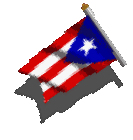


























Geography: The island of Puerto Rico is almost rectangular in shape, and is the smallest and the most eastern island of the Greater Antilles. In addition to the principal island, the Commonwealth includes: Vieques, Culebra, Mona, Monito and various others isolated islands. Deep oceans waters fringe Puerto Rico. The territory is very mountainous (cover 60%), except in the regional coasts, but Puerto Rico offers astonishing variety: rain forest, deserts, beaches, caves, oceans and rivers. Puerto Rico has three main physiographic regions: the mountainous interior, the coastal lowlands, and the karst area.
Original Inhabitants: Taíno Indians who inhabited the territory, called the island Boriken or Borinquen which means: "the great land of the valiant and noble Lord". Today this word -used in various modifications- is still popularly used to designate the people and island of Puerto Rico. The Taino Indians, lived in small villages, organized in clans and led by a cacique, or chief. They were a peaceful people who, with a limited knowledge of agriculture, lived on such domesticated tropical crops as pineapples, cassava, and sweet potatoes supplemented by seafood.
Immigration: During the early 18-century, the Spaniard in order to populate the country took Taino Indian woman as brides. Later on as labor was needed to maintain crops, and build roads. African slaves were initially imported, shortly followed by the importation of Chinese immigrants, then continued with the arrival of Italians, French, German, and even Lebanese people. The most significant new immigrant population arrived in the 1960s, when thousands of Cubans fled from Fidel Castro's Communist state. The latest arrivals to Puerto Rico have come from the economically depressed Dominican Republic. This historic intermingling has resulted in a contemporary Puerto Rico without racial problems.
Agriculture: Until 1955, agriculture constituted Puerto Rico's main economic sector. Sugarcane, mostly for export to the American market, was the main crop, followed by coffee and tobacco. Sugarcane production declined as prices remained low, agricultural labor migrated to the United States, and urban expansion took over much sugarcane land. Coffee production, taking place mostly in the mountainous areas away from the pressures of urban expansion and supported by guaranteed minimum prices, has remained stable. Tobacco production has virtually disappeared. Considerable expansion has occurred in the production of dairy products, beef, pork, eggs, and poultry, although significant amounts of these products are still imported, primarily from the United States.
Population: The 3.580 million people that inhabit the island of Puerto Rico make it one of the most densely populated islands in the world. There are about 1,000 people per square mile, a ratio higher than within any of the 50 states in the United States. It is estimated that some 2 million Puerto Ricans have migrated to the United States. Had these people remained in Puerto Rico, the island would be so densely populated that there would be virtually no room for people to live. Because of the massive migration to the mainland, more Puerto Ricans are said to live in New York City than in San Juan. The people of Puerto Rico represent a cultural and racial mix. When the Spanish forced the Taíno people into slavery, the entire indigenous population was virtually decimated, except for a few Amerindians who escaped into the remote mountains. Eventually they inter-married with the poor Spanish farmers and became known as jíbaros.
Thanks to the Welcome to Puerto Rico website for supplying the info.
I give a shout out to the Latinas from other countries, but my heart belongs to Puerto Rico!











January 2, 1851- Manuel Elzaburu (founder of El Ateneo Puertorriqueño) born in San Juan
January 6, 1752- José Campeche (painter) born in San Juan
January 9, 1897- Doña Felisa Rincón de Gautier (Co-founder of the Partido Popular Democrático and alcaldesa) born in Ceiba
January 11, 1839 - Eugenio Maria de Hostos (philosopher, sociologist and journalist) born in Mayagüez
January 24, 1874 - Arturo Alfonso "Afroborinqueño" Schomburg (Documentarian) born in Santurce
January 28, 1869 - Virgilio Dávila (poet) born in Toa Baja
February 18, 1898 - Luis Muñoz Marin (Founder of the PPD, politician and 1st native born governor of Puerto Rico) born in San Juan
March 2, 1917 - President Woodrow Wilson signs the Jones Act giving Puerto Ricans U.S. citizenship
March 9, 1940 - Raul Julia (actor) born in San Juan
March 20, 1898 - Luis Pales Matos (poet) born in Guayama
March 22, 1873 - Spain abolishes slavery in Puerto Rico
April 8, 1827 - Ramón Emeterio Betances (physician and Politician) born in Cabo Rojo
April 16, 1866 - José de Diego (barrister, journalist and politician) born in Aguadilla
April 22, 1957 - First Pablo Casals Festival in Puerto Rico Rio Piedras)
May 14, 1876 - Luis Llorén Torres (poet) born in Juana D?az
May 16, 1857 - Juan Morel Campos (composer) born in Ponce
June 17, 1833 - Francisco Oller (painter) born in Bayamón
July 17, 1859 - Luis Muñoz Rivera (politician and journalist) born in Barranquitas
July 25, 1898 - The United States assumes custody of Puerto Rico from Spain
July 25, 1952 - Puerto Rican flag adopted
August 18, 1934 - Roberto Clemente (baseball player and humanitarian) born in Carolina
September 12, 1891 - Dr. Pedro Albizu Campos (Primary leader of the Nationalist movement) born in Ponce
September 14, 1843 - Lola Rodriguez de Tio (poet and journalist) born in San German
October 24, 1892 - Rafael Hernández (composer) born in Aguadilla
November 3, 1970 - Herman Badillo is elected to the U.S. Congress (first Puerto Rican elected)
December 11, 1931 - Rosita Dolores Alverio (Rita Moreno - actress, singer and dancer) born in Humacao
